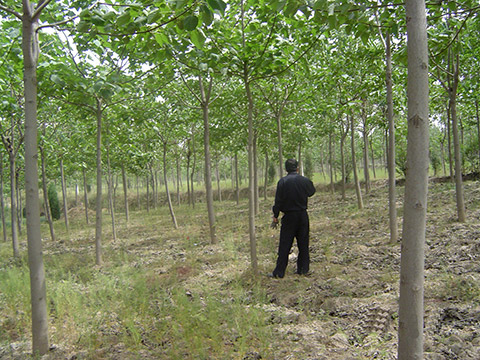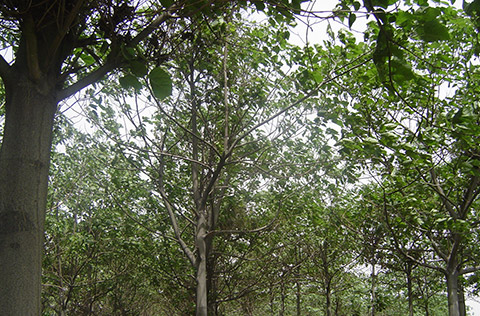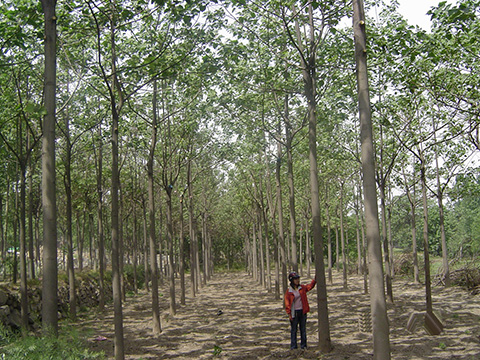Afforestation Characteristics Of Different Types Of Paulownia
The goal of commercialized artificial cultivation for Paulownia is to harvest large quantity of high-quality timber in the shortest period. With no natural factors and technological factors taking into consideration, how to select Paulownia species is the key for fast-growing and high yield, which is also the premise for preponderance production of Paulownia commodity forest and the first issue of Paulownia afforestation.
Type And Semi-Wild-Type
From the point of view of Paulownia growth habit, wild-type and semi-wild-type of Paulownia belong to natural type of Paulownia whose growth gene is benefited with pronounced natural attributes. Compared with the artificial-crossing type, such types of Paulownia are hard to be artificially planted with characteristics of larger crown, short trunk, poor growth, high production cost and poor economic return.
They all have a preference for scattered growth as individual plants when they will present their respective growth preponderance, while if planted in groups in artificial manners, their growth preponderance will be lessened representing as obvious growth difference between individual plant, overall poor growth, seriously damaged by disease and insect and poor resistance for adverse natural conditions. Even by huge amount of artificial input, significant improvement will be difficult to get.

Paulownia wood will be resistant to humidity & moisture and kept well after dying, which act as the top-grade material for lining board of passenger ship and bus, packing cases for aviation transport and water transport.
Afforestation Characteristics Of The Old Generation Of Artificial-Crossing-Type
In 1970s to 1980s, China selectively bred a host of fine varieties in the artificial-crossing-type. Until now, we have got more than 20 famous Paulownia species of the artificial-crossing-type. They are suitable for group plantation based on characters of rapid growth, broad growth scope, strong resistance against natural environment, high-quality of timber and large quantity of output.

These species of Paulownia have not only overcome the disadvantage that wild-type Paulownia species are hard to be artificially planted in groups, but also remarkably enhanced the excellent traits of their own, by which the goal of fast-growing and high-yield forest will be achieved.
During a fairly long period, these fine varieties made a great contribution to the career of Chinese Paulownia and a full step in the field of artificial plantation of Chinese Paulownia. Artificial-crossing type paulownia species researched in this period are called the old generation of artificial-crossing-type Paulownia.
Filial generation of Paulownia could completely inherit the excellent genes of the former generation through asexual multiplication. However, these excellent genes will be lost as well after long-term and repeated reproduction. The old generation of artificial-crossing type Paulownia has been applied repeatedly during the long-term of production, so there are too many excellent genes lost in this process. Various resistances on insect, disease, drought, high-temperature, low-temperature and the growth rate are notably lessened.
Serious retrogression expressed in the current production of Paulownia has not only increased the times and scale of artificial control and tending management on disease and insect which leading to higher production costs, but also caused prolonged cutting period, poor timber quality and low volume ratio. Thus, the old generations of artificial-crossing type Paulownia species are hard to adopt commercialized plantation.
Afforestation Characteristics Of A New Generation Of Artificial-Crossing-Type
Lose of excellent genes will be less if the time for production application of the artificial-crossing Paulownia is shorter, otherwise are more. Shan Tong is a new artificial-crossing type Paulownia studied out in this century, which is called a new generation of fine variety of the artificial-crossing Paulownia.
It is proved in production practice that the artificial commodity forest built by Shan Tong under the same site conditions and technical measures will be benefited with low rate and lessened harm of disease and insect, quickened growth rate, shorter cutting period, improved timber properties and larger timber output.
In addition, owing to strong adaptability to natural conditions of the trees, fewer times of management are required in the whole process of building Paulownia forest, which brought higher economic efficiency by saving a huge amount of manpower and resources, reducing the whole afforestation cost and harvesting more quality timber in a shorter period.

As a result, in the current production of Paulownia here in China, wild-type Paulownia species are no longer applied anymore; old generation of artificial-crossing-type Paulownia, whose excellent genes having lost too much due to long production period, is stepping down from the stage of history; positive selection and introduction of a new generation of artificial-crossing type Paulownia has gradually become the mainstream of Paulownia cultivation in all parts of China.
